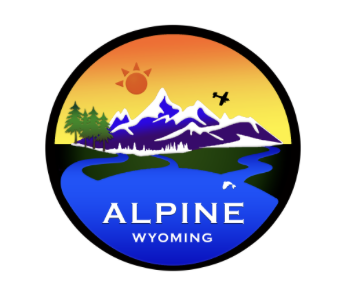
The Town Council of Alpine met with Administrators of the Lincoln County School District No. 2 and three members of the school board this month to discuss Alpine’s great desire to establish a school in the town.
Alpine officials expressed the concerns that citizens of Alpine have about the fact that there is not a school in Alpine, and school district administrators explained the challenges that the district faces in trying to educate children throughout a district that covers so many miles.
Opening the meeting, Mayor Eric Green stated that “This topic is very important to the citizens of Alpine and the surrounding area.” They feel strongly that it is time for their very young children to have an opportunity to go to school locally.
Out of the gate, board members outlined parent concerns as follows:
• The community cannot grow as readily without a school there.
• New community members choose to live in towns that have a school closer.
• Students who live in Alpine are on the bus three hours of their day.
• Many adults in Alpine work in Jackson. Their school children are over an hour away if there is an emergency. Activities like concerts and sporting events mean that parents drive an additional 35 minutes south to be in attendance.
• They are not advocating for a high school, but rather an elementary option.
• Alpine is the fastest growing town in Wyoming.
• There are many development prospects and a chance that Alpine’s population will exceed 2,000 by the year 2030 at the next census.
• The Town Council is committed to working with the school board to resolve this issue and get a school in Alpine.
• Nine acres have been set aside for a school. There is also land set aside for a ball field.
• Infrastructure of water and sewer is in place and is currently only used at 30 percent capacity.
Town Council member Jeremy Larsen was clear in his perspective. “I have a deep desire for a strong community. Having a school in your community solidifies that. The school attracts residents. When you have residents, you have volunteers – board members, volunteer firefighters, EMS, coaches. The argument [against a school] in the past has been that we don’t have the numbers. It’s got to come sooner than later – especially as we grow. [There is a publicized growth rate of] 5.5 percent in Lincoln County. Alpine far exceeds that. At the census, Alpine was up 47 percent. We are not slowing down. This whole valley isn’t slowing down. We are preparing. We are planning for our future. [A school] is a major part of it.”
LCSD No. 2 Administrators discussed the legislative processes and statutes that slow progress towards the building of a school in Alpine. The state builds build- ings based on algorithms that are dictated by building capacity, and according to district statistics, we still have room for as much as 13 percent growth before some of our buildings are full.
Superintendent Matt Erickson explained that building condition scores determine awards for “major maintenance dollars. We have been excellent stewards in taking good care of our facilities. Our condition scores for our buildings are great.” When district numbers and scores demonstrate the need, the state conducts a Mercer Study and “looks at all different solutions to the capacity or condition chal- lenge or issue.” Results from the Mercer study determine the most “cost effective remedy.”
Approximately eight years ago, LCSD No 2. capacity scores triggered a Mercer Study. “The study results in one or two best-case scenario solutions offered by the state, then it goes to the school board, and they determine which solution is most desirable.” Officials approach the facilities department again, and legislative work is done to allot funds for planning, design and construction of any buildings. “This allowed for additions to Osmond and Afton Elementary Schools as the most cost effective solutions. We have very, very little to do with it,” said Erickson.
Asking for district administrators to continue pursuing conversations with whomever might have influence, Green was very clear about Alpine’s needs. “If we don’t get this figured out, the capacity issue will be a much bigger issue.” Alpine has 160 apartment units planned and a subdivision of 300 bedrooms. “That’s why we are here now,” said Green. “We want to make sure we are doing what’s best for Alpine. If we were able to have a school here in Alpine, it would help.” Alpine stressed that it’s “tough to sell economic development opportunities if there is not a school.”
Erickson acknowledged the prob- lem as being district wide. “We see this coming as well, not just in this end of the district, but throughout Star Valley. We anticipate capacity issues in the next five to ten years. Unfortunately, we all know, when you deal with government, things are extremely slow. We are happy to advocate and try again to get a Mercer Study triggered.
Though Alpine is focusing on providing affordable housing to valley residents, challenges for the school district also include staffing. With housing prices, the district is facing a hurdle with new faculty and staff hires being able to find affordable housing. They can’t even staff the schools we already have.
J.C. Inskeep, who serves as LCSD No. 2 Director of Finance, suggested meeting with Alpine’s people to get blueprints and plans to present to the state in annual meetings that each school district is required to attend. “When we do our annual model, we have something instead of just saying it. “Here is literally the approved development. We have to get people here and put concrete in the ground. But if we can get it from you, that is a good spot to say we are not just talking, we are showing.”
Jason Horsley, who serves as one of two Directors of Education with LCSD No. 2, feels that the conversation will take the district places that it needs to go. “This is a really exciting conversation for families and students in Star Valley in my opinion – especially the forward thinking. The Superintendent mentioned that the School Facilities Commission has a complete response philosophy. When there are 10,000 people in Alpine, they are going to come to us and go, ‘Hey, that’s a great idea. You guys should have a school there.’ That’s their whole philosophy. It’s really exciting to be talking about ‘what’s the proactive approach to this?’ We don’t want to wait for them to say, ‘Wow, you have a whole bunch of kids and no space for them!’”
To support Alpine in their growth and preparation for a school, Inskeep promised to share the state statutes that define benchmarks for all building codes.
One other significant challenge for the district is transportation. “The state waits until you are way over capacity before they consider getting additional buses,” explained Ryan Lyman, LCSD No. 2 Transportation Director. “Everything that happens in transportation is a domino effect and they fall for a long, long time. The state just suggests that we make more bus runs, putting 50-60 students on each bus.”
Suggestions from the public, Alpine residents, administrators, legislators and school board members who were in attendance included considering a conversation about converting Thayne and Etna Elementary schools into Kindergarten through Sixth Grade school as opposed to the current system of Kindergarten through Third Grade students all attending in Thayne while Fourth Through Sixth Grade students attend in Etna. This change would save Alpine’s Kinder- garten through Third Grade students approximately 160 hours each school year on a bus. Erickson explained that this “is not something we can flip on a dime.”
Public comment suggested that the district find a way to trigger a Mercer Study by pushing capacity in a particular building. Parents are very concerned about the amount of time that students are away from their families, the one hour and forty-minute ride from the high school to Alpine, the amount of time that elementary school children are required to travel, the reduced amount of time they have for academics and the demands placed on them if they choose to participate in any extracurricular activities.
One ray of hope included the idea of exploring a charter school in Alpine, which was suggested at the end of the meeting. According to Erickson, charter schools are under a newly determined set of legislative guidelines, which may offer Alpine a faster solution to the problem – at least for younger students.
In conclusion, Green admitted “We are getting the gist that you are more than willing to work with us in starting the process in figuring out how to get a school in Alpine.”
Interested parties can view a recording of the entire meeting on the Town of Alpine Facebook page.





